Chapter: Modern Analytical Chemistry: Developing a Standard Method
Mathematical Models of Response Surfaces
Mathematical Models of Response Surfaces
Earlier we noted that a response surface can be described mathematically by an equation relating the response to its factors. If a series of experiments is carried out in which we measure the response for several combinations of factor levels, then lin- ear regression can be used to fit an equation describing the response surface to the data. The calculations for a linear regression when the system is first-order in one factor (a straight line). A complete mathematical treat- ment of linear regression for systems that are second-order or that contain more than one factor is beyond the scope of this text. Nevertheless, the computations for a few special cases are straightforward and are considered in this section.
Theoretical Models of the Response Surface
Mathematical models
for response surfaces are divided into two categories: those based on theory and those that are
empirical. Theoretical models are
derived from known chemical and physical rela- tionships between the response and the factors. In spectrophotometry, for
example, Beer’s law is a theoretical model relating a substance’s absorbance, A, to its concen- tration, CA
A = εbCA
where ε is the molar absorptivity, and b is the pathlength of the electromagnetic ra- diation through the sample. A Beer’s law calibration curve,
therefore, is a theoretical
model of a response surface.
Empirical Models of the Response Surface
In many cases the underlying theoreti- cal relationship between the response
and its factors
is unknown, making
impossi- ble a theoretical model of the response surface.
A model can still be developed if we
make some reasonable assumptions about
the equation describing the response sur- face. For example, a response surface
for two factors, A and B, might be represented
by an equation that is first-order in both factors
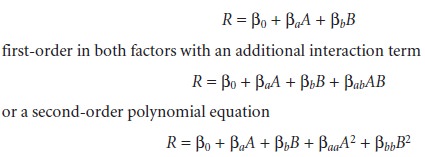
The terms β0, βa, βb, βab,
βaa,and βbb, are
adjustable parameters whose
values are de- termined by using linear regression to fit the data to the equation.
Such equations are empirical models
of the response surface because they
have no basis
in a theo- retical understanding of the relationship between the response
and its factors. An empirical model
may provide an excellent description of the response
surface over a wide
range of factor
levels. It is more common,
however, to find
that an empirical model only applies to the range
of factor levels
for which data have been collected.
To develop an empirical model
for a response surface, it is necessary to collect the right
data using an appropriate experimental design. Two popular
experimental designs are considered in the following sections.
Factorial Designs
To determine a factor’s effect
on the response, it is necessary to measure the response for at least
two factor levels.
For convenience these
levels are labeled high,
Hf, and low, Lf, where
f is the factor; thus HA is the high level for factor
A, and LB is the low
level for factor
B. When more
than one factor
is included in the
empirical model, then each factor’s
high level should
be paired with both the high
and low levels for all other factors.
In the same way, the low level
for each factor should be paired with the high and low levels for all other factors (Figure
14.12). All together, a minimum of 2k experiments is necessary, where k is the number of fac-
tors. This experimental design is known as a 2k factorial design.
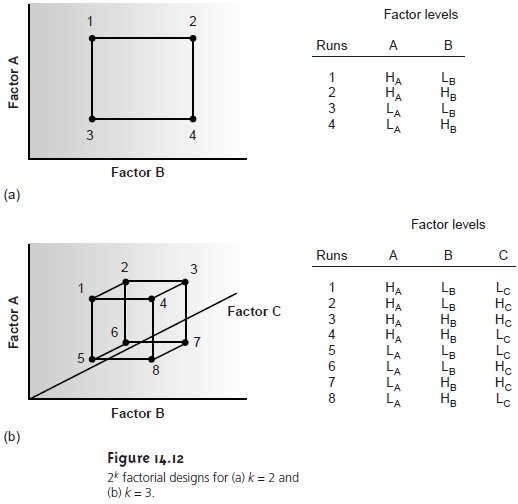
|
f |
value, xf,
is given as
xf = cf + d fxf* …………..14.3
where cf is the factor’s
average level, and df is the absolute
difference between the factor’s average level and its high and low values. Equation
14.3 is used to transform coded results back to their actual
values.

Let’s start by considering a simple example
involving two factors,
A and B, to which we wish to fit the following empirical model.

A 2k factorial design
with two factors
requires four runs,
or sets of experimental
conditions, for which the uncoded
levels, coded levels,
and responses are shown in Table
14.4. The terms
β0, βa, βb, and
βab in
equation 14.4 account
for, respectively, the mean effect (which
is the average response), first-order effects due to factors A and B, and the interaction between the two factors. Estimates
for these parameters are given by the following equations
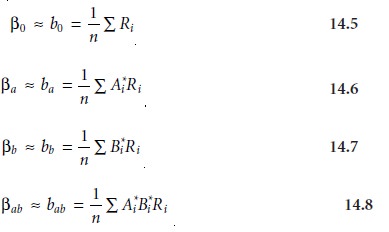

where n is the number
of runs, and A* and B* are
the coded factor levels for the ithrun.
Solving for the estimated parameters using the data in Table 14.4
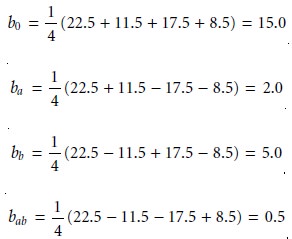
leaves us with the following empirical model for the response
surface
R =
15.0 + 2.0A* + 5.0B* + 0.5A*B* …………..14.9
The suitability of this model
can be evaluated by substituting values
for A* and B*
from Table 14.4 and comparing the calculated response to the known
response. Using the values for the first run as an example
gives
R = 15.0 + (2.0)(+1) + (5.0)(+1) + (0.5)(+1)(+1) = 22.5
which agrees with the known response.
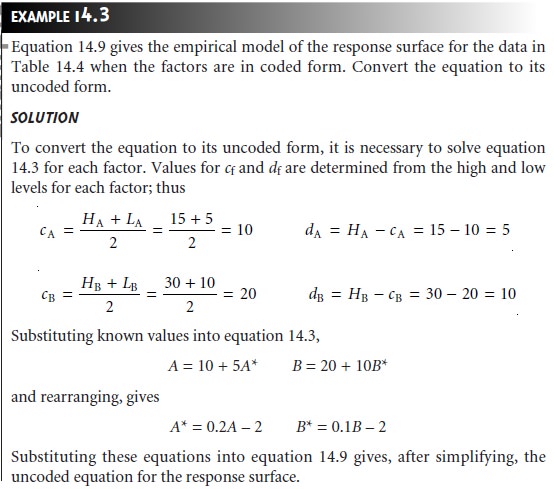
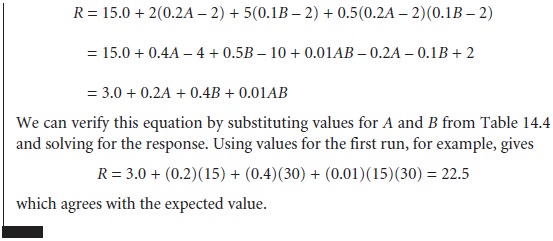
The computation just outlined is easily extended
to any number of factors.
For a system with three factors,
for example, a 23 factorial design can be used to deter-
mine the parameters for the
empirical model described by the following equation

where A, B, and
C
are the factors. The terms β0, βa, βb and βab
are estimated using equations 14.6–14.9. The remaining
parameters are estimated
using the following equations.

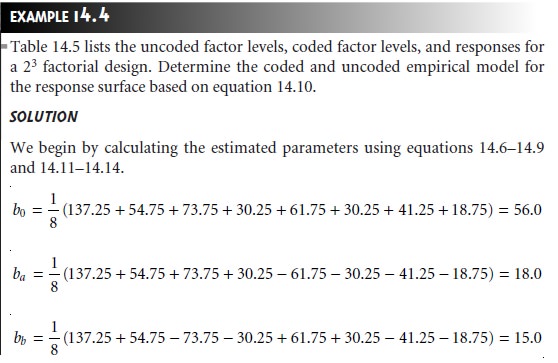
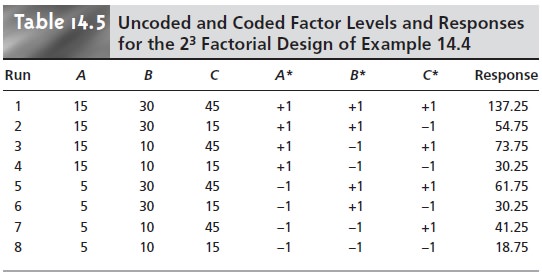
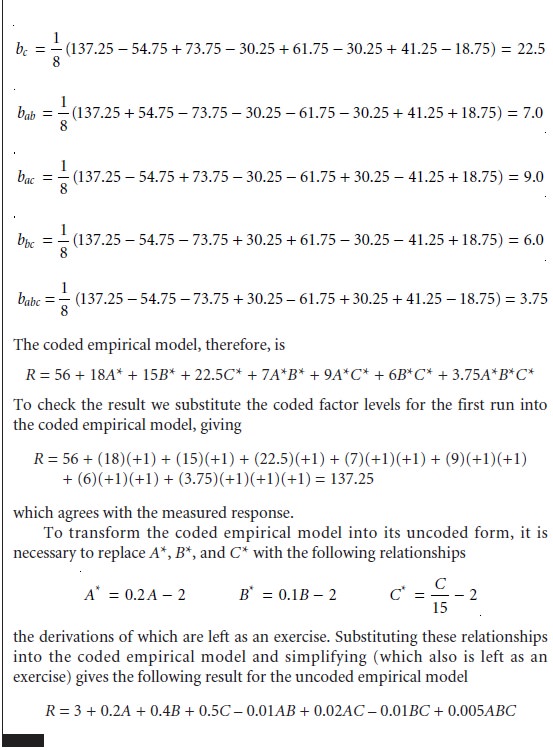
A 2k factorial design is limited
to models that include only a factor’s
first-order effects on the response. Thus,
for a 22 factorial design, it is possible to determine the first-order effect for each factor (βa and
βb), as well as the interaction between the factors
(βab). There is insufficient information in the factorial design, however, to determine any higher order
effects or interactions. This limitation is a consequence of having only two
levels for each
factor. Consider, for
example, a system
in which the response is a function of a single
factor. Figure 14.13a
shows the experimentally measured response
for a 21 factorial design in which
only two levels
of the factor are used. The
only empirical model
that can be fit to the data
is that for
a straight line.

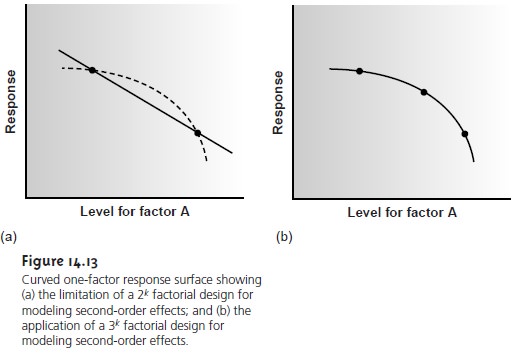
If the actual
response is that represented by the dashed
curve, then the empirical
model is in error. To fit an empirical model
that includes curvature, a minimum of three levels must be included for each factor.
The 31
factorial design shown
in Fig- ure 14.13b,
for example, can
be fit to an empirical model that includes second-order effects for the factor.

In general, an n-level
factorial design can include single-factor and interaction terms up to the (n – 1)th order.
The effectiveness of a first-order empirical model can be judged
by measuring the response
at the center of the factorial design.
If there are no higher
order effects, the average
response of the runs in a 2k factorial design
should be equal
to the mea- sured response at the center
of the factorial design. The influence of random error can be accounted for
by making several
determinations of the
response at the
center of the factorial
design and establishing a suitable confidence interval. If the differ-
ence between the two responses
is significant, then a first-order empirical model is probably not appropriate.

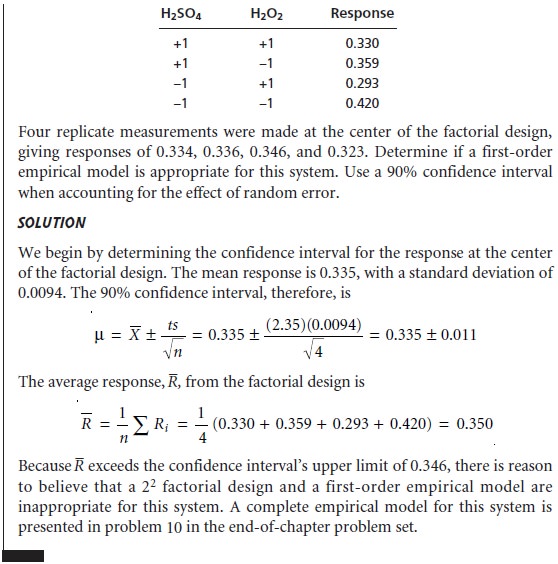
Many systems that cannot be represented by a first-order empirical model can be
described by a full second-order polynomial equation, such as that for two factors.

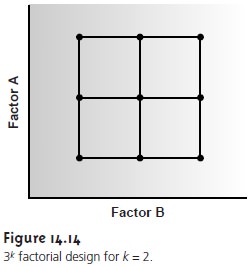
Because each factor
must be measured for at least
three levels, a convenient experi- mental design is a 3k factorial design.
A 32
factorial design for two factors,
for exam- ple, is shown in Figure 14.14.
The computations for 3k factorial designs
are not as easily generalized as those
for a 2k
factorial design and
are not considered in this text.
Central Composite Designs
One limitation to a 3k factorial design is the number of trials that must be run. For two factors, as shown in Figure 14.14, a total of nine trials is needed. This number increases to 27 for three factors and 81 for four factors. A more efficient experimental design for systems containing more than two factors is the central composite design, two examples of which are shown in Figure 14.15. The central composite design consists of a 2k factorial de- sign, which provides data for estimating the first-order effects for each factor and interactions between the factors, and a “star” design consisting of 2k + 1 points, which provides data for estimating second-order effect. Although a central com- posite design for two factors requires the same number of trials, 9, as a 32 facto- rial design, it requires only 15 trials and 25 trials, respectively, for systems involving three or four factors. A discussion of central composite designs, includ- ing computational considerations.
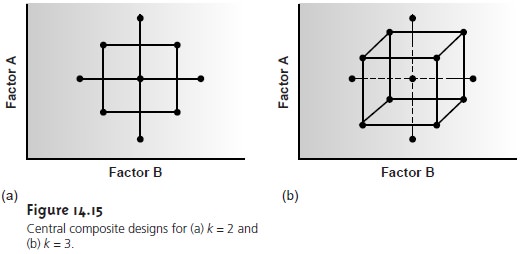
Related Topics